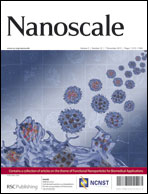Rough contact is not always bad for interfacial energy coupling
Abstract
For the first time we report that by introducing sub-nm roughness on a Si surface, the energy coupling between a single layer graphene (SLG) and the Si substrate can be improved substantially. This is contrary to the traditional view that a rough surface contact will weaken the energy coupling, rather than improve it. Periodical grooves of 2 nm width and 2 nm spacing are introduced on the surface of a Si substrate. It is surprisingly found that when the groove depth (δ) is less than 0.54 nm, the interfacial thermal resistance decreases against the increasing δ (more than 10% decrease at δ = 0.54 nm). The observed finding is explained soundly with the interfacial C–Si bond tuning by the surface roughness. For δ < 0.54 nm, the C–Si bond length in the suspended graphene region is large, and graphene experiences a strong pulling-down force (attractive) from the Si substrate. On the other hand, the graphene in the supported region is in direct contact with Si and experiences an extremely strong repulsive force to balance the pulling-down force in the suspended region. The repulsive force on graphene in the supported region can reach a level of 228 MPa. This significantly increases the local energy coupling and offsets the energy coupling reduction in the suspended graphene region. The discovery in this work points out that for extremely soft materials like graphene, it is possible to tune the material–substrate bonding by introducing sub-nm roughness on the substrate surface to significantly improve interfacial energy coupling.


 Please wait while we load your content...
Please wait while we load your content...